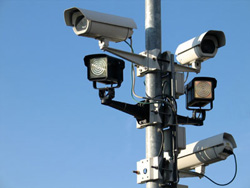Call for More Video Cameras Spotlights Debate on Use
Daily News Article — Posted on April 22, 2013
 (by Jennifer Valentino-DeVries and Geoffrey A. Fowler, The Wall Street Journal) – Video cameras played a critical role in helping authorities track suspects in this week’s Boston bombings. Now calls for increased camera surveillance in the U.S. are putting a spotlight on the technology and the debate about its use.
(by Jennifer Valentino-DeVries and Geoffrey A. Fowler, The Wall Street Journal) – Video cameras played a critical role in helping authorities track suspects in this week’s Boston bombings. Now calls for increased camera surveillance in the U.S. are putting a spotlight on the technology and the debate about its use.
Authorities Thursday distributed video footage and still images of suspects in the Boston case, drawing from surveillance video from a store, restaurants and other areas. Some lawmakers think use of a better-connected system of cameras controlled or monitored by law enforcement might have helped speed the suspects’ identification.
“They had to piece together I don’t know how many thousands of videos,” said Rep. Peter King, a New York Republican who is on the House Committee on Homeland Security. “I think CCTV [closed-circuit television] cameras are much more needed in urban areas.”
But privacy advocates remain concerned about pervasive, and potentially invasive, surveillance technology.
Government use of surveillance technology has expanded considerably in the past decade, amid advances in computing as well as government spending on homeland security. Such technology includes a high density of cameras in some urban centers, traffic cameras along highways, and well as the use of advanced technology such as facial recognition in airports.
New York City’s surveillance effort includes about 3,000 cameras and was recently extended to midtown from downtown.
“The Boston bombing is a terrible reminder of why we’ve made these investments – including camera technology that could help us deter an attack, or investigate and apprehend those involved,” New York Mayor Michael Bloomberg said this past week. He added the network now has the ability to “alert police to abnormalities it detects on the street, such as an abandoned package that is left on a corner.”
Boston also has a surveillance-camera network, although it is unclear whether cameras in that network were the ones that recorded the bombing suspects.
As of 2007, there were nearly 150 cameras in the Boston area’s networked system, according to a public-records request filed by the American Civil Liberties Union of Massachusetts in 2010. Documents also showed that the Massachusetts Bay Transportation Authority had more than 400 security cameras in its system and was adding more.
“Over time we are finding that sophistication is improving and the costs are going down,” said Bill Bratton, a consultant who also served as chief of police in Los Angeles and commissioner of Boston and New York City’s police departments. “We are going to see in years ahead…more attention being placed on mounting cameras that can do multiple things,” he said, such as traffic cameras that can also be used by investigators.
London has a reputation as the world’s surveillance capital, but estimates of the number of cameras in the city and the rest of the U.K. are inexact. One widely quoted study claimed there were 500,000 CCTV cameras in London and four million cameras in the country, while another estimated fewer than two million in the U.K. Most of these cameras are privately owned.
“The U.S. has not just met London’s standard, it has actually surpassed it,” thanks to facial recognition and other technology, said Laura K. Donohue, a professor at the Georgetown University Law Center. But American law doesn’t yet provide clear limits on the use of such technology, because most of it is deployed in areas that are considered public space, she said.
Some privacy advocates said the ability of investigators to track the suspects within a matter of days demonstrates that more invasive surveillance isn’t needed. “It’s one thing to have private closed-circuit cameras and look at feeds after the fact,” said Alan Butler, a lawyer with the Electronic Privacy Information Center. “It’s very different if you’re talking about systems of cameras identifying and tracking people over time, all the time. Especially if you couple that with facial recognition and license-plate readers and databases.”
